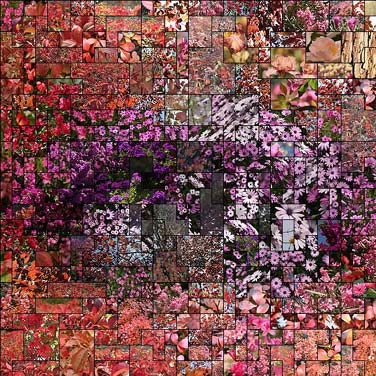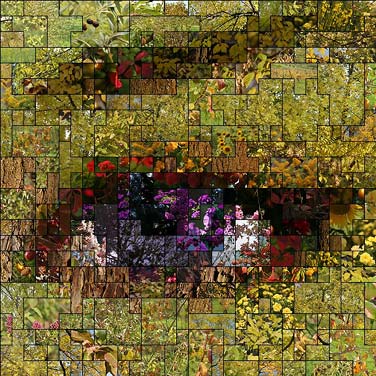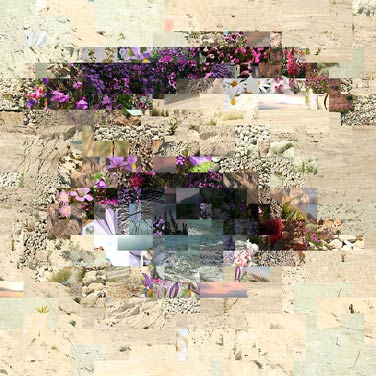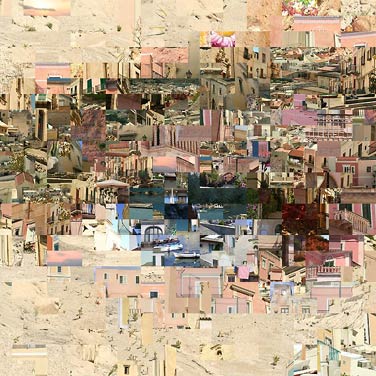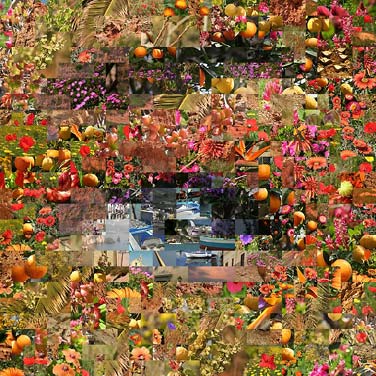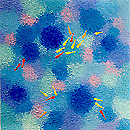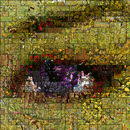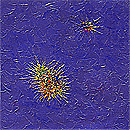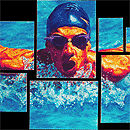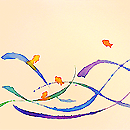This is the on-line gallery of young contemporary artist Riccardo Paci. The images present in this virtual art gallery show his paintings in oil on canvas and watercolours, as well as his digital art works. The topics presented by the artist range from Water to Eyes, Stars, Fish and Nature. In addition, the Large works section also presents three large oil paintings made of several canvases and a work in cardboard on wood, the link between the artist’s works on canvas and his digital prints. The site sets out, in the artist’s own words, his approaches to the different techniques:
Digital Art
Discover the secrets of the "puzzle of photos"
I discovered digital art relatively late on, but with great passion and interest. I had always been struck by the computer’s potential to form “casual” designs, but also using it as a means to actually create an image. Having started off from painting, which had soon led to breaking down the images into subparts (see the Large works and in particular the work Eye on the Checks), I ended up disassembling the digital image into portions of other images. In concrete terms, if you enter the whole, that is, the portrayed subject, you find it is made up of single photographs of leaves, flowers, plants, bushes and trees as if nature had provided the atoms to create the final work. These works, which I named puzzle of photos, combine photography and IT processing. Therefore, I can alternate periods of pure programming with periods of pure photography when I spend hours and hours in the woods, meadows and monumental gardens, but also looking out flowerbeds or flower exhibitions. The final work is a Lambda print that include many intersecting photographs on the topic of nature, all taken by myself, each present only once. And it was one of these digital works, Eye 9, that won the international competition The Brain Project.
Photography
I have been dabbling in photography since the age of five when I was given my first reflex camera. At that time my parents printed their photographs at home, periodically transforming the bathroom into a dark room. In 1998 I went from Nikon to Canon. Finally I arrived to the digital reflex when my puzzle of photos were taking an increasingly solid and interesting shape. The photographs shown on this site are all on the topic of Nature and are part of the great archive of images needed to create the Eyes digital works.
Oil paintings on canvas
The painting technique I like best is oil on canvas, since you can sculpt the matter as you paint. And it is the matter itself, and its three-dimensional properties, that makes it possible to read the work on another level: while running over the surface of the canvas, the eye can “feel” what is explicit to the touch, allowing you to read the work in its entirety. In the figurative pictures, portraits, landscapes (not shown on this site, but the technique can be seen in the large oil multi-canvas paintings The Swimmer and Great Chicks), I always start off by priming the canvas, that is, by forming a flat base of colour. This base can be completely covered by piling on lots of paint, or it can transpire under more diluted colours. As a rule, I follow the guidelines of the Impressionists: I use lots of paint on the light areas, while I use more diluted colours on the shaded areas. On more abstract canvases, like the Water or Stars paintings for instance, I sculpt the matter using several types of spatula. In this case, the fact that the work can be read in three dimensions becomes more explicit. For example, in the Water topic, I use the paint to create definite patterns representing the action of the wind on water. Of fundamental use for me in achieving a balance of the matter, that is, a better equilibrium between the forms and thicknesses of the painted surface, were the wood sculpting and modelling courses that I attended at the Istituto d'Arte in Florence (professors Gerardo Meccia, Carlo Fagnini and Paolo Lauton).
Water Colours
Water colours require a good technique and very clear ideas. Right from the very first brush stroke, you already need to know how to let the water and colour flow, which parts to leave blank (the light parts) and when it’s time to let the whole thing dry to then start off again with the desired effect. I first approached the water colour medium after seeing an exhibition by the Spanish artist Pedro Cano at the Falteri Gallery in Florence, and then being fortunate enough to take part in some of his lessons. The period that I devoted to water colours was very important for sharpening my sensitivity towards transparency and becoming confident of my painting technique. A painting technique also needed to make up oil canvases like the ones in the Water and Stars topics. This site does not show my more “classic” water colours on the topic of Fruit, but the more “graphic” ones which I consider more interesting and modern: the Fish series.

